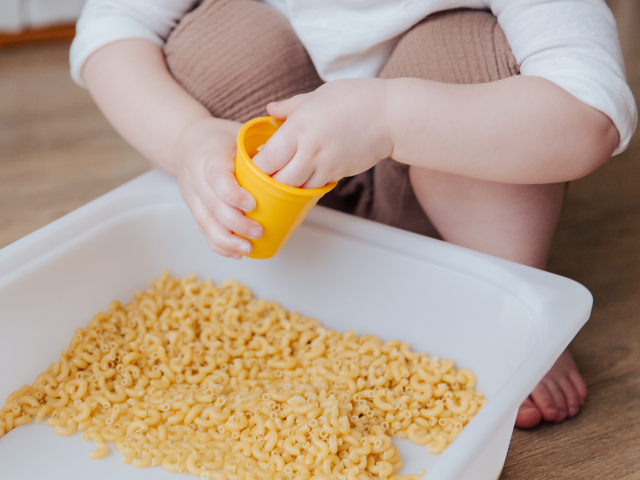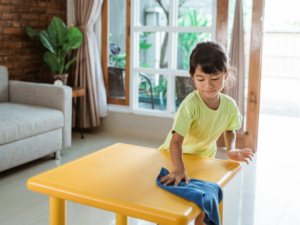Getting messy is a wonderful sensory play experience for young children, and I recommend it. However, sensory integration is more complicated than just getting your hands dirty. Here’s a quick glimpse into what sensory processing means.
A child’s sensory system picks up information from the child’s surroundings. It sends that information to the nervous system, which processes it and generates a response or reaction to what is happening around him. This is sensory processing-the way the body receives, analyzes, and responds to the signals it receives from its environment.
The sensory systems include auditory, visual, touch, smell, taste, movement, and body position. Thoughtful, guided exposure to playful sensory experiences is the best way to promote the healthy development of the sensory systems. This ensures that little bodies learn to process, integrate, and generate appropriate responses to the sensory information in their environments.
Here are eight practical sensory play activities and objects you can try at home to support healthy sensory processing:
Sensory Play with Bins
Sensory bins are an excellent way to encourage tactile sensory play. They are perfect for introducing new textures and exploring new sensations. Sensory bins are containers filled with material that kids can feel and manipulate with their hands. The materials can be messy, clean, wet, or dry. Some of my favorite fillers include beans, noodles, and rice. Sensory bins can be adapted to children’s individual sensory needs simply by changing the materials inside. A wide variety of materials is available for sensory bins.
Tips: If your child is hesitant to join in the play, start with dry materials and add only one material at a time. Gradually introduce new textures and encourage your child to explore new sensory experiences slowly. Encourage your child to play with the sensory bin using a familiar or comforting toy, such as by pushing a train or car through the bin.
Sensory Play with Bottles
Sensory bottles, discovery bottles, sensory jars, or calm down jars – whatever you call them – are clear containers filled with various materials to encourage visual exploration. Bottles are helpful for babies, toddlers, and children of all ages. You can use them as a calming visual sensory experience or challenge visual skills in kids.
Tips: Test out a variety of objects and materials. You can try a bottle with one material, two materials, or even several. The possibilities are endless.
Sensor Play with a Sound Lab
The setup for this auditory play idea is straightforward. Create a “sound lab” and intrigue your child with the power of sound. Next, place all the buckets and containers in a large bin, then place all the other objects in another bin nearby. For this simple play, you do not need to provide much direction because you will want to see how your child explores the various materials independently. Start by showing your child how to turn the containers upside down inside the bin, like drums. Then show him how to make different sounds by dropping the other materials onto the overturned containers. Let imagination take over-your child may want to turn the containers right side up or even sideways. He may want to find other objects around the house to drop in the containers. He may have different ideas for containers to use as drums.
Tips: This activity is excellent for exploring soft and hard or loud and quiet sounds. Ask your child to describe some of the sounds that he made. Which containers and objects made the loudest sounds? The softest? Which combination was his favorite?
Sensory Play Through Cooking
Cooking helps children learn functional skills and independence. Smoothies are a great place to start. They are simple to make and fun to taste, which makes them the perfect oral sensory activity. Have your child measure out each ingredient, and starting with milk, pour all the ingredients into the blender. Blend until all the ingredients are mixed and the ice cubes are as small as possible. Pour into cups and enjoy.
Tips: Encourage your child to suck the smoothie through a straw. Sucking is an organized sensory activity that increases focus and attention.
Sensory Play with Bubble Wrap
This recycled art activity presents tactile, vestibular, proprioceptive, and auditory play opportunities. You could not pack many more sensory experiences into one activity. Stomping and jumping on bubble wrap makes for a full-throttle, high-energy painting experience. Find a clear space outside and roll out the paper. Squirt paint in drops or lines on the paper. Then place the bubble wrap on top of our paint design and let your child jump all over it with bare feet until they cannot jump anymore. Slowly pull off the bubble wrap to see the results.
Tips: Be sure to weigh down the paper on the ends with rocks or another heavy object, so the wind does not carry it away. Try all sizes of bubble wrap to explore the different effects and sensory experiences.
Sensory Swing Activities
Flying through the air on a swing is just about the best entertainment for many kids. However, this activity is also full of excellent sensory benefits. Vestibular input is essential for developing balance and helping children feel safe and secure as they explore and play. Swinging is a great way to provide your child with this sensory input.
Tips: Not all children respond positively to the vestibular input provided by swinging. Start slowly for one minute at a time. Watch how your child responds. Stop immediately if he becomes agitated, distressed, sick, or upset during swinging.
Scented Play Dough
Mix extracts or scented oils into a simple homemade play dough recipe.
Couch Cushion Games
Playing with couch cushions is the ultimate heavy work experience. These big heavy pillows are perfect for lifting, pushing, pulling, jumping on, knocking over, and throwing. All you need is just the cushions from your couch!
Tips: Let your child lift, stack, and arrange the pillows as much as possible for an added heavy work bonus.



